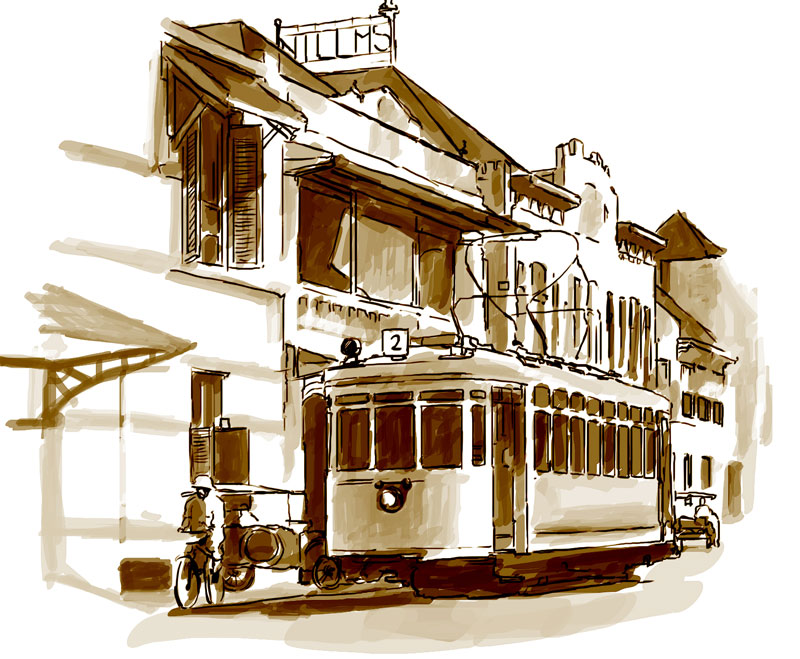
Both pantograph poles still stand nonchalantly, watching over the bustling crowds walking along Jalan Rajawali every day with no signs that they will succumb to the changing times. Both poles still stand firmly there, despite 44 years without electricity. They have become one of the city’s lasting relics, witnesses of the past glory of steam and electric trams crisscrossing the city more than a century ago. These poles that once supplied the electricity to get the tram going is our starting point for a story about the trams in the past.
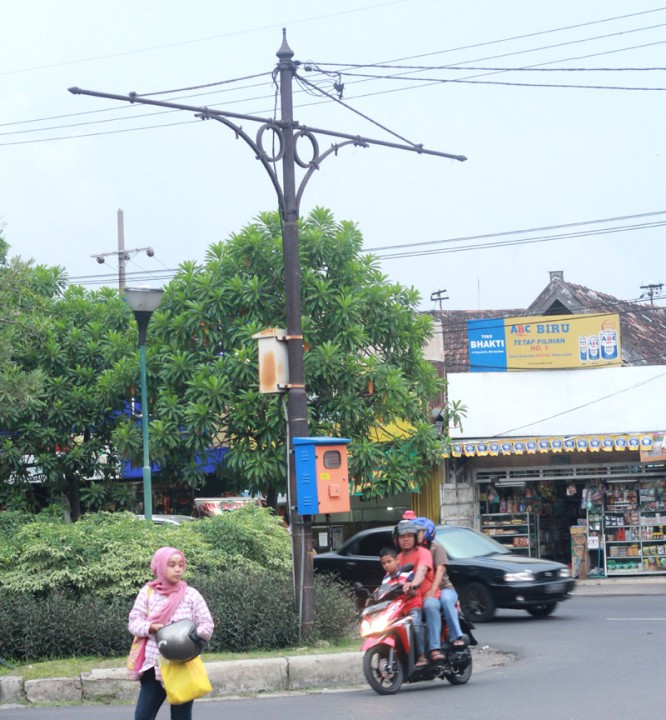
The pantograph pole in Jalan Rajawali. Photo: Firman (Surabaya Tempo Dulu)
Smoke in Jalan Diponegoro
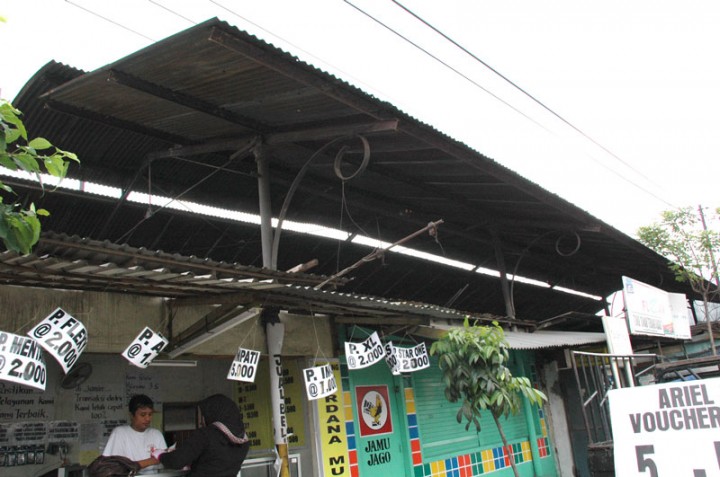
In Karangpilang we can find the last remaining tram station in Indonesia. The stop is an elongated building built inn a minimalist art nouveau style with a grocery store and a shop selling mobile phone credit. Foto: Firman (Surabaya Tempo Dulu)
The steam tram was the first type of tram built in Surabaya, but was closed in 1975. The tram used to depart from a station in Wonokromo. Its route was as follows: Jalan Diponegoro – Road Arjuno – Pasar Turi – Kebon Rojo – Cantikan – Ampel – Fort ending at the edge of the Navy Base. While its southern route led from Gunungsari, through Karangpilang to Pull, Mojokerto. Karangpilang is the site of the last remaining tram stop in Indonesia. The stop is an elongated building built inn a minimalist art nouveau style with a grocery store and a shop selling mobile phone credit.
The legacy of the steam tram can still be seen on Java, much of the infrastructure still remains, in pieces. A wide area at Waringin, near Terminal Joyoboyo, is a former tram depot for steam and electric trams. It is a large warehouse-like building with concrete walls that have slowly begun to be covered by growing moss. Another building, with the words “ANNO 1913” written on the wall is where steam trams stopped to rest after a day of serving passengers. The sounds of hammers and the hiss of welding mechanics have been replaced by the buzzing silence of private cars of the residents around. The location now functions as a paid parking area.

Steam tram station in Wonokromo. Photo: Firman (Surabaya Tempo Dulu)
Two pairs of R25 rails emerge on top of a culvert on Jalan Diponegoro, 50 meters from RKZ (St. Vincent) Hospital. Their nuts and bolts are still screwed in completely, looking as if they could withstand the force of B12 locomotive, an example of which stands as a monument at Pasar Turi Station. But the chugging smoke of B12 has never again been seen along the road of Jalan Diponegoro—Arjuno, the rail line has been replaced with a green line and a flyover at Pasar Kembang.
The steam tram used to pass through Jalan Semarang, Pasar Turi, Kebon Rojo, Semut until Ampel and end at Ujung. Remembering the overcrowded trams, the carriages full of groups of santri and kyai doing their pilgrimage to the tomb of Sunan Ampel during the month of Ramadhan, or the boisterous jokes by the Dutch sailors who had arrived at the base of Ujung. Everywhere we can still see remains of tram rails emerge from asphalt. There are some near Bank Mandiri Kebon Rojo, Jalan KH Mas Mansyur and towards the entrance of Lantamal Ujung. The rails remain buried there.
Membelah Jalan Darmo menuju Jembatan Merah
The Wonokromo tram station is the ground zero in the history of tram transportation in Surabaya. Inside this long-shaped building, just across the Joyoboyo North Terminal, is the only place that steam and electric trams shared during the active period. From Wonokromo, line 1 of the first electric tram starts, serving the route of Wonokromo – Red Bridge.
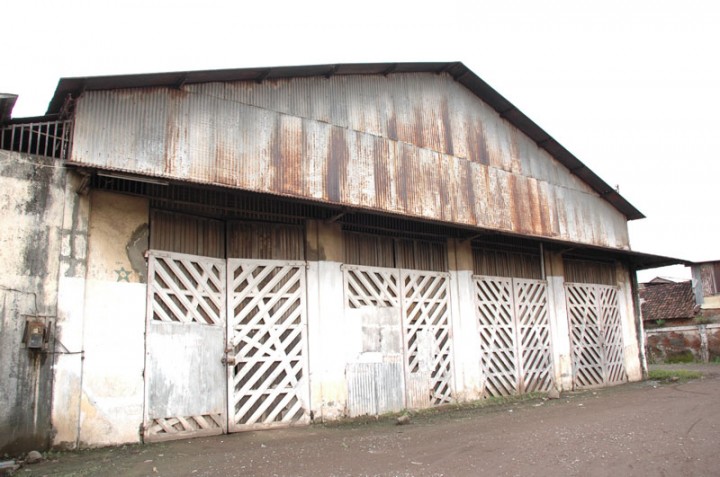
Electric tram station in Wonokromo. Photo: Firman (Surabaya Tempo Dulu)
Wonokromo – Red Bridge line was the busiest and longest lines of all existing electric tram lines. The line was served by 13 pairs of electric cars. One pair consisted of 2 cars and sometimes added an open carriage for transportation to market traders in the morning. Passengers ranged from civil servants, private sector employees to school children, all crammed into the tram cars together.
During the colonial period, tram passengers were divided into classes: 1st class for the Dutch, and 2nd class for indigenous people. After Independence in 1945, the class became defined through ticket price. Tickets for 1st class was 15 cents, 2nd class 10 cents.
Silent witness of this pathway can be found in the remains of rail trolleys along Jalan Kepanjen directly opposite the Cathedral and Frateran Catholic School. These tracks then turn towards Jalan Veteran, the arches are still visible on the side rails of Mapolwiltabes Surabaya.
One of these pathways is in a unique spot in Kebon Rojo, which will remind us of the first book of the Buru trilogy by Pramoedya Ananta Toer. And it is here where the twin paths of the rails separate again. One lane goes straight into Jalan Veteran and one turns to the front of the Post Office in Kebon Rojo, the former Hogere burgerschool (HBS), where Minke from This Earth of Mankind, and Sukarno, our first President, went to school. This is where the electric trolley lines and steam tram cross. Imagine how exquisite the view of the city would be if they were still active. The traffic at this crossing is managed by an officer. Amazingly, a collision between a steam and electric tram never occurred.
Visiting CBZ with tram
There is nothing left of the Goebeng Boulevard stop. This tram stop is located right in front of the restaurant Ayam Goreng Suharti, and it has now been turned into a children’s playground. Not many former trolleys that can be found in Jalan Gubeng other than a highway that was once wide enough to accommodate the tram line in the middle.
The stop in front of the station has been turned into a Japanese food restaurant. Further along, the trams run along the sturdy bridge, now known as the Monkasel bridge, built by the renowned architect C.Citroen. This line was the route usually used by the doctors, nurses and families of patients going to visit (bezoek) CBZ Hospital (Centrale Burgerlijke Ziekenhuis). Like the tram lines, the hospital is no longer there, replaced by a shopping center named Surabaya Plaza.
Line 2 which runs from Gubeng to Red Bridge is finally united with line 1 at the intersection of Jalan Pemuda and Jalan Panglima Sudirman, to then move on to the Red Bridge.
To distinguish the routes of electric trams from steam trams, we can read plates located on the front and back of the tram. This way of reading the routes from the front and rear, as well as the term “lyn” (line), have been passed on to the minibus transport (bemo) in Surabaya to today.
Going to Perak
Until the 1990s, along the green belt of Jalan Perak Barat and Jalan Perak Timur, we could still see double track electric tramway serving Lyn 4 Red Bridge – Tanjung Perak. Now all that remanins is a rail that hangs over the ditch near a police post and the two pantograph poles at Jalan Rajawali mentioned at the beginning of this article.
The passengers on lyn 4 were mostly passengers for the ships leaving from Tanjung Perak. Rush hour occurred in the morning and afternoon. The passengers on the tram during these hours were mostly ship and port labourers from Tanjung Perak. Tired faces of port workers, PELNI employees and workers packing inside the DAMRI bus going to Perak every afternoon today mirror the looks sported by passengers of Lyn 4 in the past.
This route is unique due since it has three intersection points with railroads along its path. All these intersections show how Surabaya in the past is a city formed by the criss-crossing of these iron pathways on every corner of the city. It can even be said that the bulk of Surabaya’s livelihood depended on the interchangeable activities passing over these iron belts.
Going home to Sawahan
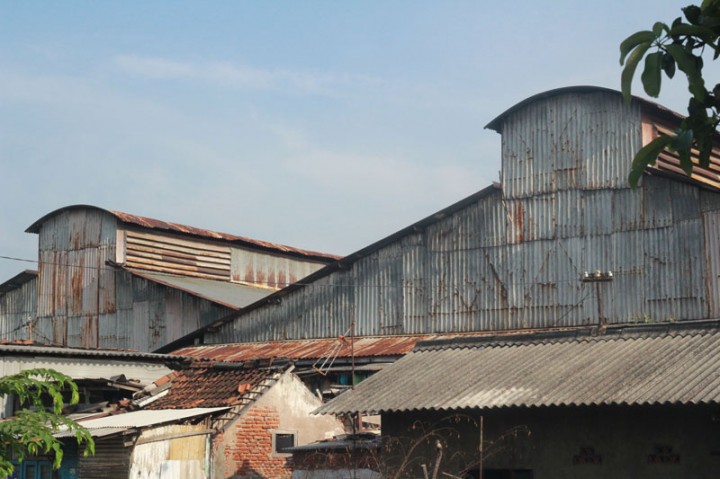
Electric tram station in Sawahan. Foto: Firman (Surabaya Tempo Dulu)
The two large buildings at the end of the road extending to Tidar still exude their splendor despite the surrounding crowded settlements. On the walls of these buildings we can find “Soerabaia” stencilled beneath some asbestos. These two large barn-shaped buildings are actually the Sawahan Tram Depot, where all electric trams started their busy routine at 5 am every day and returned to at 10 pm. This tram depot in its heyday had 12 lines to maintain. Everything is all gone now, turned into storage rental business that supposedly belongs to PT KAI.
Sawahan is also the starting point of the line serving the Lyn 3 from Gubeng to Sawahan. This route runs both Lyn 1 and 2 before they split at the junction between Tunjungan Embong Malang and streets. Piles of rail between rubber stamp and sticker stalls on Jalan Embong Malang are sad clues to the tram lines that had passed this way long ago.
Intersections of tram lines at Jalan Arjuno are also now long gone. There are no visible signs along Jalan Tidar, although there are some potholes in the middle of road, that usually form in the middle of rainy season, sometimes uncover signs of these rails. All pantograph poles that once supplied the electricity have also disappeared. The line of children waiting for trams at Don Bosco School have now been replaced by lines of private cars picking them up.
Houses in art deco style marked with “PROPERTY of PT KAI” around the tram depot Sawahan reveals them as important relics of PT KAI. Rail bars now converted as access into houses in the gutter reveals the past existence of Sawahan Tram Depo.
The life behind
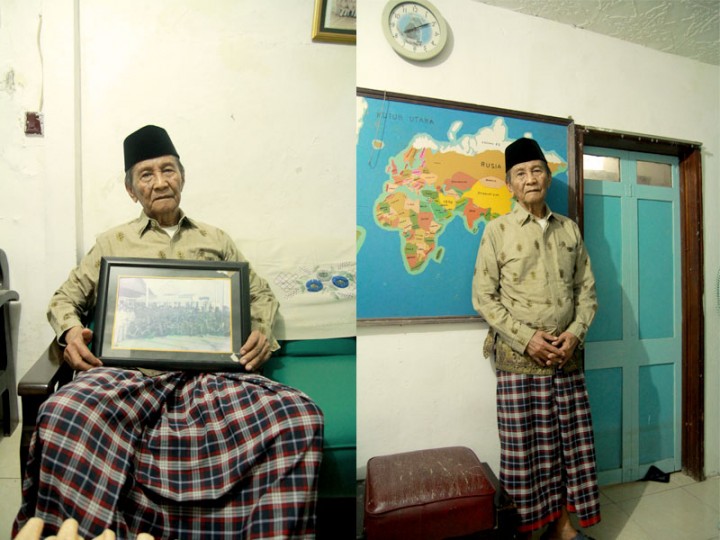
Pak Abdul Azis, 90 years old, the last electric tram driver alive. He scavenged the door in the photograph from the skeletal remains of old trams. Photo: Firman (Surabaya Tempo Dulu)
Traces of the once triumphant electric tramways are not only found through the relics of artefacts scattered throughout the city but also through history passed down through through families of descendants of officers and workers of the electric tram living on the east side of Sawahan Tram Depot. Few people know that amongst the residents, it is still possible to meet living witness who never tire of re-telling stories of the trams back in the day.
One of them is named Abdul Aziz. From the way he tells his stories, we would not believe that this spirited man is already 90 years old. Mr. Abdul Aziz is the only electric tram driver who is still alive. For those who’ve never heard of the electric tram era, Mr. Abdul Aziz can create a vivid picture. In fact, most of the information gathered here comes from Mr. Abdul Aziz’s recollections.
Mr. Abdul Aziz still remembers when pickpockets were a problem in the tram system. The pickpockets, he said, often slipped in from the Metro store in Jalan Tunjungan. He would throw out these pickpockets before they could carry their acts. He also still remembers how to drive a tram, and the way the brakes emitted some humming sounds peculiar to the tram at that time. He also recalled that the trams back then never had a single power shortage.
Mr. Abdul Aziz had an unforgettable experience when the tram he drove crashed into a Harley Davidson driven by a traffic cop. This incident, which happened at Lyn 4 at Jalan Perak, sent the police and his bike bounding into a ditch. This incident had made Mr. Abdul Aziz summoned into the Mapolwiltabes Surabaya. Rather than being reprimanded, though, the police even apologized for the careless actions of their junior officer.
Occasionally he wiped away tears, remembering that fellow motorist trams are now all gone. Every now and then he snarled, when he recalled the number of building facilities and tram lines that have been sold by PT KAI and converted into other buildings. He mourns quietly when he sees the old wagons disfigured, their parts sold.
Mr. Abdul Aziz has saved the few remaining items of electric trams in Surabaya. In fact, there are two doors in his house, which are made from tram doors he scavenged from the skeletal remains of old trams. Seeing this two doors, we imagine them like the gates of a time machine. Perhaps when we open it, we can feel the boisterous atmosphere of tram passengers…
They were standing crammed behind the door, hanging for dear life, facing each other. The ceiling above the seating were filled with advertisements from Unilever, Palmolive or Lindeteves Stockvis. The conductor walked among the passengers checking their tickets. They were just leaving the tram junction at Tunjungan-Genteng Besar. In front was Mr. Abdul Aziz in the driver’s seat, this time he looked 58 years younger. His right hand clutching the brake shaft, ready to use it to stop in front of Siola.
English translation edited by Martine Randolph.
This post is also available in: Indonesian



